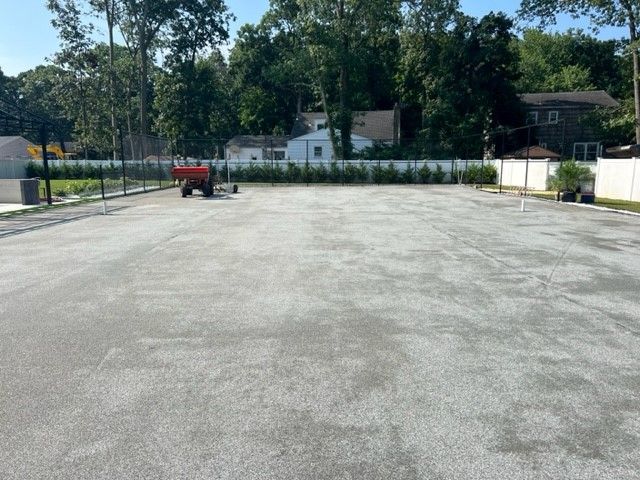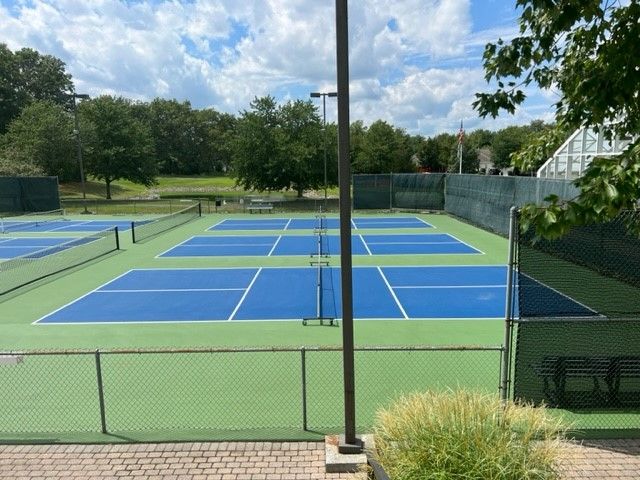Installation Details & Frequently Asked Questions for Supreme Kourts®
Serving Deal, New Jersey, and the neighboring Monmouth County and Ocean County regions, Supreme Kourts® is your go-to source for athletic court construction. Our installation technique combines accuracy and love to build courts that surpass your expectations. To find out more about our services and how we can make your vision a reality, explore our Installation details and FAQs. Call us today with any questions you have!
Installation
Supreme Kourts® proven installation program will provide you with the highest quality constructions available today. We have developed a proprietary program over the past several decades that has proven itself with our numerous successful installations.
Using the latest technology plus our unequaled experience, we prepare the site for installation. Our team will then install a concrete curb around the exterior of the court, either an above-ground or underground irrigation system. The final step is a generous layer of quality Har-Tru installed for a stunning, smooth tennis court that will last generations.
Har-Tru is a 100% environmentally compatible construction for your tennis court surface and a cost-efficient choice. The minimal need for future maintenance makes having a tennis court that meets the toughest players’ demands affordable and time-efficient. Supreme Kourts® is re-known throughout our tennis court construction industry as the finest builder of clay tennis courts. Our clay court maintenance programs include court resurfacing.
Carpet Courts
Carpet is a tennis term for any removable court covering. A short form of artificial turf weighted with sand is common in Asia. Indoor arenas store rolls of rubber-backed court surfacing and install them temporarily for tennis events. However, they are no longer used for professional events. Carpet is generally a fast surface (more than hard-court) with low bounce. Since 2009, their use has been discontinued on the ATP tour.
Indoor Courts
Indoor wooden courts date back to the dawn of tennis. Today All Weather courts are very common indoors. Slower, higher-bouncing rubberized surfaces are used for a cushioned feel. Clay courts, too, are installed indoors, generally with underground watering systems.
Supreme Kourts® constructs various All Weather acrylic color-coated tennis and basketball courts, including shock-absorbing cushion surfaces such as Cushion Extreme and Clay Tech; by Lee Tennis. Different speeds of tennis court play can be obtained by altering the desired texture of your tennis court surfaces. Supreme Kourts® provides total tennis court construction, including fencing, lighting, windscreen curtains, plus maintenance equipment. Supreme Kourts® turn-key tennis court installation assurance programs reduce costs and worry over planning problems and job coordination. By utilizing the latest technology and developing innovative construction techniques, Supreme Kourts® achieves the highest quality tennis court installations available today. Our extensive experience backs these capabilities, plus our attention to detail customer service in building quality tennis courts for over seven decades.
Supreme Kourts® maintenance program for All Weather includes clearing debris and vegetation, installing nets and net posts, fixing cracks on troubled courts with our Rite Way Crack System, and resurfacing (recommended every 5-7 years). Adding cushion to your acrylic court will provide consistent bounce, sure footing, and outstanding durability. Cushioned surfaces are healthier, respond to body impact, and reduce fatigue on the player’s legs, knees, ankles, and feet.
Our bocce and pickleball courts are built precisely as our tennis courts. All bocce courts are not the same. Our courts are built to last and offer professional and recreational players quality play. We use the proven
Har-Tru
tennis clay for the perfect surface court.
Har-Tru is rapidly becoming the preferred surface among expert bocce players. We also offer synthetic grass over concrete or crushed stone base for less maintenance and year-round play. Because bocce courts are built flat and level, they tend to hold water after rain storms.
Our courts have full drain systems to ensure quick play after any rain. Heavy 6” x 6” treated wood edging stays straight level, and does not rot. We will custom-build ball racks, scoreboards, and seating areas to complete your court. Have your family and friends over for a barbecue, a few drinks, and a good game of Bocce. All ages can play, and everyone will enjoy the prospects of a new, memorable family tradition.
Supreme Kourts® is dedicated to manufacturing the highest quality All Weather athletic court surfaces available that are 100% environmentally compatible and dedicated to strict quality control plus sensitive to budgets, schedules, and surrounding landscapes.
Cushioned Court Construction
If you have ever looked at a tennis court, it may appear to be a simple piece of asphalt or cement that is painted with lines to create a court for playing tennis. However, the court isn’t always what it seems. When you choose to install a tennis court at your selected location, Supreme Kourts®’ professionals can show you exactly what a difference a cushioned asphalt tennis court can make to your performance and the durability of the court.
When we begin the construction of a cushioned asphalt tennis court, we start by placing a layer of asphalt on the ground, covered by a layer of acrylic.
While this would end court construction for some companies, we follow up with the cushioning layers for a better playing surface. In many cases, we will add two layers of cushioning. The bottom layer of cushioning will consist of five to nine applications of rubberized cushioning.
Once this layer is complete, we follow up with two to three coats of heavy-grade rubberized granules and three to six coats of fine-grade granules. We then apply the acrylic paint you see on every tennis court. Full-size regulation courts and half courts, residential and commercial. Our clients include parks, schools, recreation centers, and apartment and condominium complexes. You can choose various colors with any tennis court to match your tastes. Hot mix asphalt spread and compacted with a uniform density and thickness on top of a sub-base. This is probably the most common tennis court in our area. While softer among
All Weather, asphalt is not crack resistant, and occasional undulations occur.
Benefits
The cushioned asphalt tennis court, the same type used for the U.S. Open, provides players many benefits. The cushioning helps protect the players from injury due to the jarring motion of running or falling. While the construction of this type of court adds between $5,000 and $11,000 to the cost of your court project, you will find the extra cost makes up for not having to resurface your court as often because of the increased durability the cushioning provides. These courts are commonly found in public parks, schools, apartments, and private residences. They are mostly made of asphalt or concrete. All Weather, unlike clay or Har-Tru courts, can be customized to the customer’s preferred color(s) and speed. Additional games, such as volleyball, basketball, etc., can be lined on the court surface. Both asphalt and concrete courts can be tailored to have the same amenities. The only difference is in their core construction.
The American Sports Builders Association (ASBA) recommends that an asphalt tennis court is 4+ inches of compacted base material and 1.5″ of asphalt, followed by an acrylic color coating system (for non-freeze thaw climates). In freeze-thaw climates, the compacted base should be 6″+, and the asphalt should be 3″+. Typical concrete courts are 4 inches thick, followed by a similar acrylic color coating system. An option to consider for either hard court is a cushioning system.
Frequently Asked Questions
Here are some commonly asked questions regarding tennis court resurfacing and repair. These address most of the questions people have with construction, repair, and resurfacing, but if you have another question regarding Basketball, Bocce or any courts not listed, please fill out the form on our contact page. We will get back to you as soon as we can.







